by Rhett A Bulter 2019 closed out a “lost decade” for the world’s tropical forests , with surging deforestation from Brazil to the Congo Basin, environmental policy roll-backs, assaults on environmental defenders, abandoned conservation commitments, and fires burning through rainforests on four continents. The following covers some of the biggest rainforest storylines for the year. The list isn’t exhaustive, so if there are important things missing, feel free to add them via the comment function at the bottom.
Global forests
A team led by Matt Hansen of the University of Maryland updated their annual tree cover loss dataset and added a new dataset on primary forest loss, a breakthrough development for monitoring global forests. According to the data,
the tropics lost around 12 million hectares
(around 46,300 square miles) of tree cover last year, of which 3.64 million hectares was primary forest, the most biodiverse and carbon-dense type of forest. 2018’s tree cover loss was down nearly 30 percent from its 2016 high, but 2019 may well break that record given the extent of forest fires across the Amazon, Indonesia, and Africa this year. [caption id=“attachment_7851021” align=“alignnone” width=“1000”]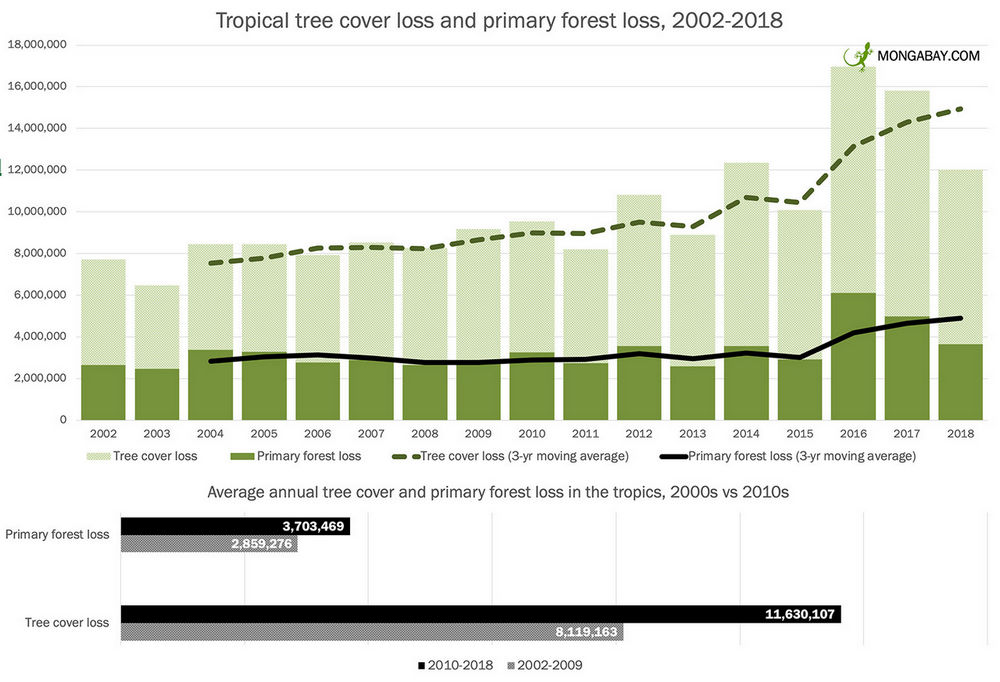 global tropical_forest_loss_2010s_2000s All data Hansen et al 2019 same data used on Global Forest Watch[/caption]
global tropical_forest_loss_2010s_2000s All data Hansen et al 2019 same data used on Global Forest Watch[/caption]
Ecosystem services from forests
Several studies highlighted the potential of forests to help in the battle against climate change.
Research published in Proceedings of the National Academy of Sciences (PNAS)
calculated that “young forests” — those under 140 years old — are sequestering carbon at a faster rate (1.17 to 1.66 billion metric tons per year) than old-growth forests (950 million to 1.11 billion metric tons of carbon per year). That trend is expected to accelerate as old-growth forests continue to be diminished in extent, a concern underlined by
a study in Science Advances
which concluded the carbon footprint of intact tropical forest loss was six times greater than earlier estimates due to unaccounted effects of forest degradation, fragmentation, and wildlife loss. A study published in Nature Geoscience
estimated the carbon sequestration value of forest elephants
, concluding that pachyderms increase carbon storage by changing forest structure. “We found that at a typical density of 0.5 to 1 animals per square kilometer, elephant disturbances increase aboveground biomass by 26 to 60 tons per hectare,” said Simone Aparecida Vieira, one of the authors of the study, via a press release. But hunting is having a huge impact on animals in tropical forests,
reducing populations of large mammals by 40 percent on average
, according to work published in PLOS Biology. [caption id=“attachment_7851011” align=“alignnone” width=“1280”] PORTO VELHO, RONDÔNIA, BRAZIL. Aerial view of burned areas in the Amazon rainforest, in the city of Porto Velho, Rondônia state. image credit: Victor Moriyama / Greenpeace[/caption] A Journal of Tropical Ecology paper confirmed that
plantations do not replace natural forests
when it comes to ecosystem services or biodiversity, even long after abandonment.
Plantations, agroforestry plots, and other “planted forests” are also a poor substitute for natural forests
when it comes to carbon sequestration, said scientists writing in the journal Nature. And
regrowing forests in the Amazon aren’t recovering
to the extent needed to match the carbon sequestration of old-growth forests, found another study published in Ecology. Plants rely on carbon dioxide for growth, but scientists have long warned that higher temperatures and reduced rainfall could diminish the capacity of forests to keep pace with rising atmospheric CO2 levels.
A study published in March in Biogeosciences
provided further confirmation for this concern, finding that the carbon uptake of global forests isn’t keeping up with CO2 emissions from human activities. Several studies looked at the importance of forests beyond carbon sequestration. A paper published in the journal Proceedings of the National Academy of Sciences found that
deforestation in Malawi diminished access to clean water
: the country’s 14 percent loss of forest 2000 and 2010 effectively reduced access to safe drinking water by nine percent. A study published in PLOS One reported that
climate change could reduce humidity in tropical cloud forests and high elevation páramo grasslands
, potentially dooming these biodiverse ecosystems. Research published in Environmental Research Letters provided further evidence that
forests reduce the intensity of cyclones
. Brazil’s lack of hurricanes is often cited as an example of this phenomenon, with the Amazon rainforest effectively sapping tropical storms of their strength before then can develop into more damaging hurricanes.
PORTO VELHO, RONDÔNIA, BRAZIL. Aerial view of burned areas in the Amazon rainforest, in the city of Porto Velho, Rondônia state. image credit: Victor Moriyama / Greenpeace[/caption] A Journal of Tropical Ecology paper confirmed that
plantations do not replace natural forests
when it comes to ecosystem services or biodiversity, even long after abandonment.
Plantations, agroforestry plots, and other “planted forests” are also a poor substitute for natural forests
when it comes to carbon sequestration, said scientists writing in the journal Nature. And
regrowing forests in the Amazon aren’t recovering
to the extent needed to match the carbon sequestration of old-growth forests, found another study published in Ecology. Plants rely on carbon dioxide for growth, but scientists have long warned that higher temperatures and reduced rainfall could diminish the capacity of forests to keep pace with rising atmospheric CO2 levels.
A study published in March in Biogeosciences
provided further confirmation for this concern, finding that the carbon uptake of global forests isn’t keeping up with CO2 emissions from human activities. Several studies looked at the importance of forests beyond carbon sequestration. A paper published in the journal Proceedings of the National Academy of Sciences found that
deforestation in Malawi diminished access to clean water
: the country’s 14 percent loss of forest 2000 and 2010 effectively reduced access to safe drinking water by nine percent. A study published in PLOS One reported that
climate change could reduce humidity in tropical cloud forests and high elevation páramo grasslands
, potentially dooming these biodiverse ecosystems. Research published in Environmental Research Letters provided further evidence that
forests reduce the intensity of cyclones
. Brazil’s lack of hurricanes is often cited as an example of this phenomenon, with the Amazon rainforest effectively sapping tropical storms of their strength before then can develop into more damaging hurricanes.
Tipping point for the Amazon?
As 2019 closed out, two eminent scientists Carlos Nobre and Thomas Lovejoy warned that
the Amazon rainforest has reached a critical tipping point
much sooner than expected, meaning the future of the biome is now at stake due to changes in precipitation patterns caused by the combination of deforestation, degradation, fire, and climate change. “What we predicted is now being observed in real life,” said Nobre, a researcher at the University of São Paulo. It’s no longer a theoretical forecast about the future.” Nobre and Lovejoy made their dire statement in a commentary published December 20 in
Science Advances
, pointing to recent research showing that
the Amazon is in the midst of a sustained drying trend
and that Amazon tree communities are shifting from rainforest species to drier forest species. That raises the prospect that the Amazon is already transitioning from rainforest to wooded savanna, a scenario that numerous studies have warned could be the outcome if deforestation and climate change reached critical thresholds. The development would have major implications for climate change given the amount of carbon stored in the Amazon’s tropical vegetation and soils. It would also affect rainfall patterns across South America and beyond since the Amazon functions as a giant regional water pump, potentially
putting regional agriculture and power generation at risk
. The impact on wildlife in the world’s most biodiverse forest would be immense. [caption id=“attachment_7851001” align=“alignnone” width=“1280”]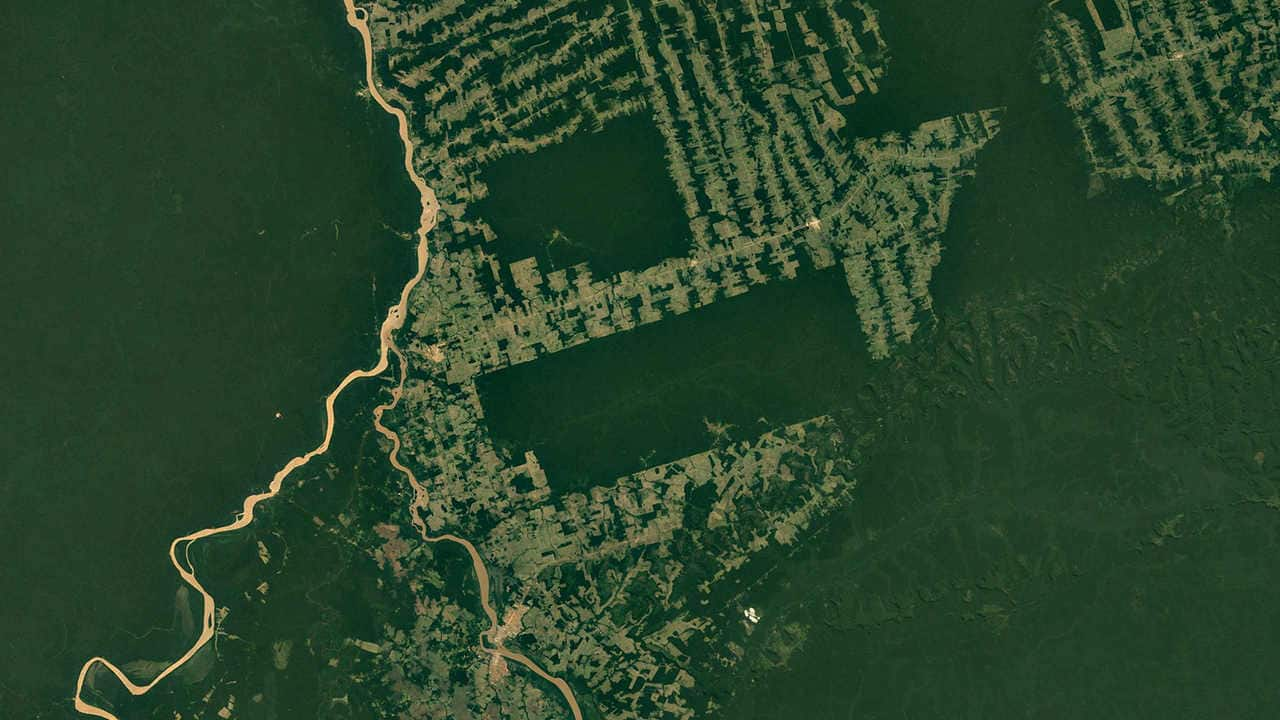 Igarapé Lage, State of Rondônia, Brazil[/caption] A separate paper, published in May,
forecast a 1.5 degree Celsius rise in temperature
in the Amazon region by 2050 due to forest loss. Fires in the Amazon are also reducing water security by
increasing the rate of glacier melt in the tropical Andes
by depositing “black carbon” or soot on ice surfaces, according to a paper in
Nature Scientific Reports
. A separate paper, published in Water by WWF-Brazil and Imazon, found that
the Amazon Basin has been losing an average of 35,000 hectares of surface water per year
since 1985 due to dam construction, deforestation, and dry trends. Floodplains and lagoons–which function as critical habitats for a range of species–are particularly affected.
Igarapé Lage, State of Rondônia, Brazil[/caption] A separate paper, published in May,
forecast a 1.5 degree Celsius rise in temperature
in the Amazon region by 2050 due to forest loss. Fires in the Amazon are also reducing water security by
increasing the rate of glacier melt in the tropical Andes
by depositing “black carbon” or soot on ice surfaces, according to a paper in
Nature Scientific Reports
. A separate paper, published in Water by WWF-Brazil and Imazon, found that
the Amazon Basin has been losing an average of 35,000 hectares of surface water per year
since 1985 due to dam construction, deforestation, and dry trends. Floodplains and lagoons–which function as critical habitats for a range of species–are particularly affected.
Review: The Americas
Brazil
Brazil is the world’s largest tropical rainforest country. Appropriately, it also accounted for a large share of the rainforest news in 2019. After the election of President Jair Bolosnaro in late 2018, who campaigned on the idea of seizing indigenous territories and national parks in the Amazon and turning these lands over to miners and ranchers, indigenous peoples and the conservation community were braced for a difficult 2019. Their fears proved astute: Deforestation jumped to levels not seen in over a decade; murders of environmentalists surged; and
the Bolsonaro administration laid the groundwork for an all-out assault on Earth’s largest rainforest
, including opening up protected areas to mining and agricultural conversion,
dismantling environmental law enforcement
, and actively encouraging deforestation. Within 100 days of taking office, Bolsonaro fired a large number of staff at Brazil’s environmental agency IBAMA, reduced its authority to enforce environmental laws, and required the agency to make public announcements — including the time and location — in advance of planned raids on illegal loggers. Beyond the substantive efforts to undercut environmental protections, the Bolosnaro administration launched petty feuds with celebrities (
Gisele Bundchen
,
Leonardo DiCaprio
,
Greta Thunberg
) and world leaders who expressed concern about the impact of its policies (e.g. Bolsonaro mocked the physical appearance of French president Emmanuel Macron’s wife and rejected fire fighting aid from France) . Environmentalists didn’t go down without a fight however. Their rights and territories threatened,
indigenous communities put up heated resistance
, while
eight former environmental ministers condemned Bolsonaro’s policies
.
A group of Brazilian lawyers took steps to indict Bolsonaro at the International Criminal Court
for encouraging genocide against indigenous people, while scientists expressed alarm that
Bolsonaro’s policies could quickly push the Amazon to a critical tipping point
. Within a few months of Bolsonaro taking office, it was clear that the situation on the ground in Amazon was fast deteriorating for its forests and native peoples. When data from Brazil’s National Institute of Space Research (INPE) showed a surge in deforestation,
Bolsonaro disputed the numbers
,
claiming — without evidence — they had been manipulated
and
sacking INPE director Ricardo Magnus Osório Galvão on August 2
. Shortly thereafter, the agency suspended
publication of deforestation data
in the midst of rumors that
Bolsonaro was seeking a private tender to replace Brazil’s world class deforestation monitoring system
. [caption id=“attachment_7851051” align=“alignnone” width=“1000”]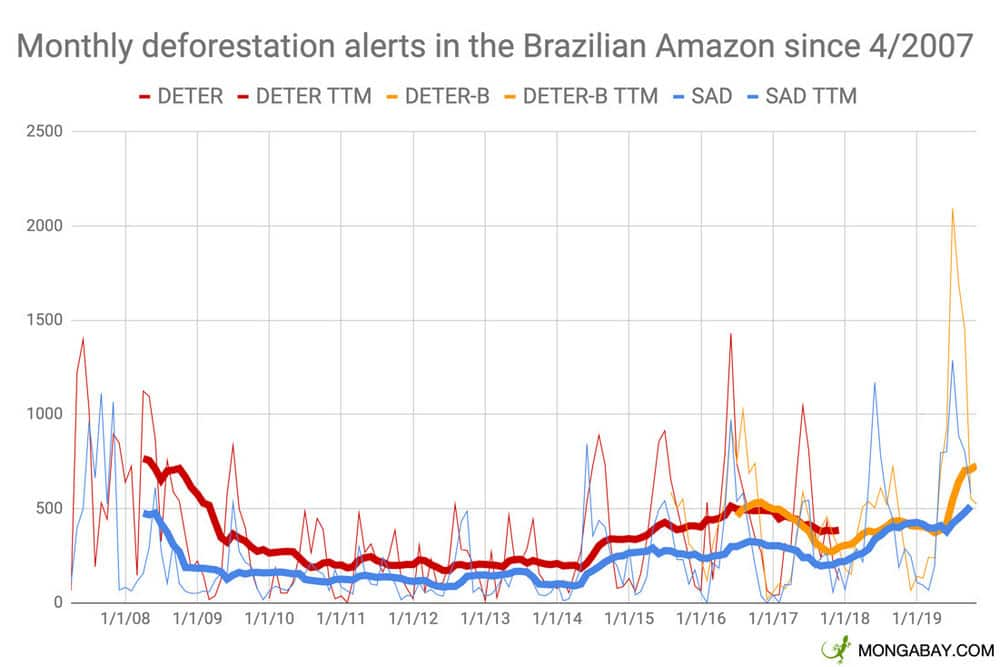 SAD is Imazon’s deforestation alert system. DETER is INPE’s deforestation alert system.[/caption] While Bolsonaro tried silence his nation’s space agency and deny the rise in deforestation,
he couldn’t hide from satellites
, which confirmed a jump in forest destruction. Still the world wasn’t paying a lot of attention to these issues until a weather phenomenon drove smoke from fires burning in the Amazon over Sao Paulo
blackening the skies mid-day
. The apocalyptic scene above one of the world’s largest cities made global headlines, provoking internal outcry. Criticism of Bolsonaro’s policies intensified. The
E.U. threatened to cancel a long-negotiated trade deal
, while
Germany suspended aid
and
Norway’s largest pension fund KLP threatened divestment from Brazilian companies associated with deforestation
. The fires caused a wide range of companies — with prodding from activists — to
examine and re-evaluate their supply chains
for deforestation and fire risk, including for
products that move through China
like
cattle / leather
and
soy
. A number of celebrities also
pledged support
to groups working in the Amazon. NGOs with Amazon in their name saw a wave of donations, while Ecosia, an eco-friendly search engine alternative to Google,
experienced an explosion in traffic
. #PrayforAmazona trended widely on Twitter. Facing this escalating backlash
as well as protests at home and threats of global boycotts of Brazilian business, Bolsonaro
backtracked on some of his inflammatory remarks
and sent in the military to assist with firefighting. But Bolsonaro
stopped short of taking any meaningful policy measures to undo his damage
and soon returned to
blaming environmentalists and NGOs for the fires
, without offering evidence for the claims.
His misinformation campaign
was echoed by
supporters domestically and abroad
. While Bolsonaro faced condemnation from some political leaders, especially in Europe, he found support from politicians in Amazon states, the United States, and China. In
a September meeting with nine Amazon state governors
, the governors of Acre, Roraima, Tocantins, Rondônia, Amazonas, Mato Grosso and Amapá backed opening up larger parts of the Amazon to deforestation, agribusiness, mining and
new roads and railways
. In another September meeting, Bolsonaro and President Donald Trump cut a deal to promote private-sector development in the Amazon using a $100 million biodiversity conservation fund. And
President Xi Jinping of China
, didn’t seem too outwardly concerned about fires or deforestation during in an October meeting with Bolsonaro, despite China’s recent posturing as a leader on climate and its plan to host the U.N. Convention on Biodiversity (CBD) next year. In October, Brazil’s national development bank
BNDES suspended new projects under the Amazon Fund
, citing the decision by Germany and Norway to freeze contributions to the fund in August. The European countries took the step after
Brazil said it would shift foreign aid from Amazon conservation projects to cattle ranchers and soybean farmers
. No one was surprised when Brazil in November announced a sharp uptick in deforestation for the year ending July 31, 2019,
reaching the highest level since 2008
. Official data published by Brazil’s National Space Research Institute INPE showed deforestation in the Brazilian Amazon between August 1, 2018 and July 31, 2019 amounted to 9,762 square kilometers, an increase of 30 percent over the prior year. But those numbers didn’t even
encapsulate the peak deforestation season
, so
the expectation is next year will be far worse
. [caption id=“attachment_7851041” align=“alignnone” width=“1000”]
SAD is Imazon’s deforestation alert system. DETER is INPE’s deforestation alert system.[/caption] While Bolsonaro tried silence his nation’s space agency and deny the rise in deforestation,
he couldn’t hide from satellites
, which confirmed a jump in forest destruction. Still the world wasn’t paying a lot of attention to these issues until a weather phenomenon drove smoke from fires burning in the Amazon over Sao Paulo
blackening the skies mid-day
. The apocalyptic scene above one of the world’s largest cities made global headlines, provoking internal outcry. Criticism of Bolsonaro’s policies intensified. The
E.U. threatened to cancel a long-negotiated trade deal
, while
Germany suspended aid
and
Norway’s largest pension fund KLP threatened divestment from Brazilian companies associated with deforestation
. The fires caused a wide range of companies — with prodding from activists — to
examine and re-evaluate their supply chains
for deforestation and fire risk, including for
products that move through China
like
cattle / leather
and
soy
. A number of celebrities also
pledged support
to groups working in the Amazon. NGOs with Amazon in their name saw a wave of donations, while Ecosia, an eco-friendly search engine alternative to Google,
experienced an explosion in traffic
. #PrayforAmazona trended widely on Twitter. Facing this escalating backlash
as well as protests at home and threats of global boycotts of Brazilian business, Bolsonaro
backtracked on some of his inflammatory remarks
and sent in the military to assist with firefighting. But Bolsonaro
stopped short of taking any meaningful policy measures to undo his damage
and soon returned to
blaming environmentalists and NGOs for the fires
, without offering evidence for the claims.
His misinformation campaign
was echoed by
supporters domestically and abroad
. While Bolsonaro faced condemnation from some political leaders, especially in Europe, he found support from politicians in Amazon states, the United States, and China. In
a September meeting with nine Amazon state governors
, the governors of Acre, Roraima, Tocantins, Rondônia, Amazonas, Mato Grosso and Amapá backed opening up larger parts of the Amazon to deforestation, agribusiness, mining and
new roads and railways
. In another September meeting, Bolsonaro and President Donald Trump cut a deal to promote private-sector development in the Amazon using a $100 million biodiversity conservation fund. And
President Xi Jinping of China
, didn’t seem too outwardly concerned about fires or deforestation during in an October meeting with Bolsonaro, despite China’s recent posturing as a leader on climate and its plan to host the U.N. Convention on Biodiversity (CBD) next year. In October, Brazil’s national development bank
BNDES suspended new projects under the Amazon Fund
, citing the decision by Germany and Norway to freeze contributions to the fund in August. The European countries took the step after
Brazil said it would shift foreign aid from Amazon conservation projects to cattle ranchers and soybean farmers
. No one was surprised when Brazil in November announced a sharp uptick in deforestation for the year ending July 31, 2019,
reaching the highest level since 2008
. Official data published by Brazil’s National Space Research Institute INPE showed deforestation in the Brazilian Amazon between August 1, 2018 and July 31, 2019 amounted to 9,762 square kilometers, an increase of 30 percent over the prior year. But those numbers didn’t even
encapsulate the peak deforestation season
, so
the expectation is next year will be far worse
. [caption id=“attachment_7851041” align=“alignnone” width=“1000”]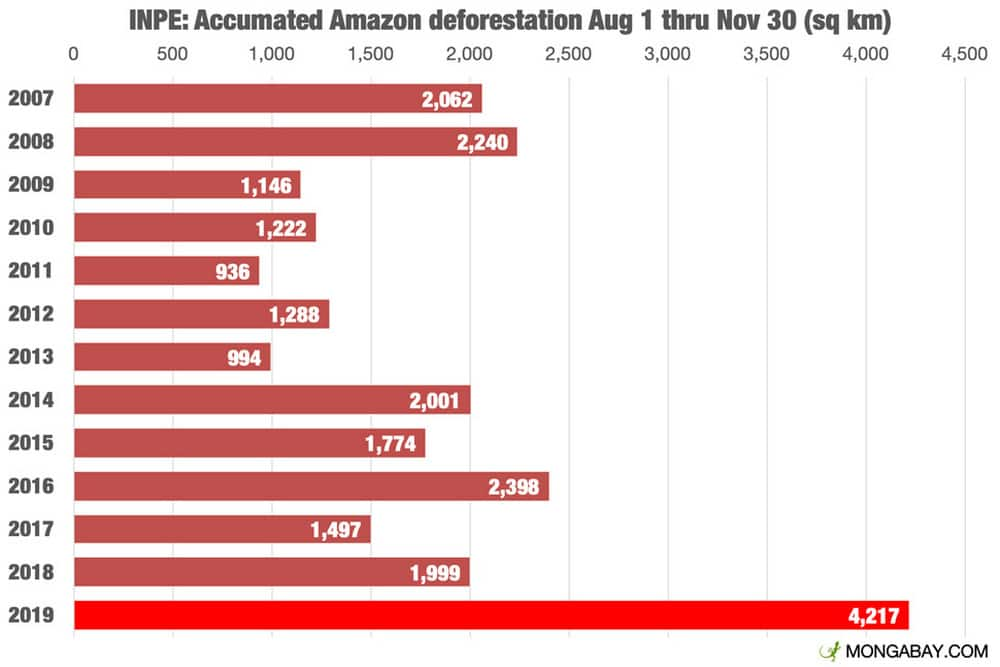 Accumulated Amazon deforestation from 1 August to 30 November.[/caption] Analysis of the areas burned during this year’s fire season showed that most of the burning visible by satellites occurred in
areas where trees had been recently chopped down, agricultural landscapes, and drier transition forests
. However, the actual on-the-ground impact is still untold given that sub-canopy fires aren’t easily detectable by satellite. Sub-canopy fires are particularly damaging in the Amazon, greatly increasing tree die-off and the likelihood of future fires and deforestation. After the official deforestation numbers came out, Bolsonaro again accused NGOs of starting fires,
blaming volunteers of Brigada de Alter of starting fires in the Alter do Chão Reserve
. But observers said land grabbers, who have a history of forest clearing in the area, had a much stronger motive for setting the fires. The Brigada de Alter volunteers were eventually released without charges. Bolsonaro did face some resistance to his policies from courts, public prosecutors, and lawmakers. For example, in May
the lower house of Congress restores the indigenous affairs agency Funai’s land demarcation powers
, though that measure didn’t stop
land invasions
or increased violence against indigenous Brazilians. Invasions of indigenous territories increased from 109 for the whole of 2018 to 160 through the first nine months of 2019, according to the
Catholic Indigenous Missionary Council
. In November, Bolsonaro disappointed environmentalists when
his administration revoked a decree that barred new sugar cane plantations from the Amazon
. But at climate talks in Spain in December,
Environment Minister Ricardo Salles told the Associated Press
Brazil would accept financial aid from rich countries to help rein in rising deforestation.
Accumulated Amazon deforestation from 1 August to 30 November.[/caption] Analysis of the areas burned during this year’s fire season showed that most of the burning visible by satellites occurred in
areas where trees had been recently chopped down, agricultural landscapes, and drier transition forests
. However, the actual on-the-ground impact is still untold given that sub-canopy fires aren’t easily detectable by satellite. Sub-canopy fires are particularly damaging in the Amazon, greatly increasing tree die-off and the likelihood of future fires and deforestation. After the official deforestation numbers came out, Bolsonaro again accused NGOs of starting fires,
blaming volunteers of Brigada de Alter of starting fires in the Alter do Chão Reserve
. But observers said land grabbers, who have a history of forest clearing in the area, had a much stronger motive for setting the fires. The Brigada de Alter volunteers were eventually released without charges. Bolsonaro did face some resistance to his policies from courts, public prosecutors, and lawmakers. For example, in May
the lower house of Congress restores the indigenous affairs agency Funai’s land demarcation powers
, though that measure didn’t stop
land invasions
or increased violence against indigenous Brazilians. Invasions of indigenous territories increased from 109 for the whole of 2018 to 160 through the first nine months of 2019, according to the
Catholic Indigenous Missionary Council
. In November, Bolsonaro disappointed environmentalists when
his administration revoked a decree that barred new sugar cane plantations from the Amazon
. But at climate talks in Spain in December,
Environment Minister Ricardo Salles told the Associated Press
Brazil would accept financial aid from rich countries to help rein in rising deforestation.
Peru
A report from Global Witness revealed that over 60 percent of the timber inspected by Peru’s Agency for the Supervision of Forest Resources and Wildlife (OSINFOR) in the Loreto and Ucayali regions is illegal. In December 2018, the Peruvian government attempted to move OSINFOR under the Ministry of Environment , but was strong-armed by the U.S. government into keeping it as an independent agency . An analysis released by the Monitoring of the Andean Amazon Project (MAAP) found that deforestation from illegal gold mining hit records in 2017 and 2018 when more than 18,000 hectares of forest was destroyed. In February, the government declared a state of emergency in Madre de Dios and sent in 1,500 police and military officers to crackdown on wildcat mining. In March, the government opened a military base in the region to support the operation. The Peruvian Palm Oil Producers’ Association (JUNPALMA) pledged to eliminate deforestation for palm oil production by 2021 . If the deal holds, Peru will be the second country in South America after Colombia to establish a zero deforestation commitment for palm oil. The commitment was secured by the National Wildlife Federation in collaboration with the local government, growers, and local NGO Sociedad Peruana de Ecodesarrollo.
Colombia
Colombia registered the first drop in deforestation since the 2016 peace deal with the FARC
(Fuerzas Armadas Revolucionarias de Colombia), reporting 198,000 hectares (489,269 acres) of forest loss in 2018, down 10 percent from 2017. The peace agreement brought stability to areas that were once off-limits to agribusiness due to the threat of violence. Technology giant Apple disclosed more details on
a carbon conservation project it’s supporting
in a Colombian mangrove forest. In September, Colombia hosted a summit between seven Amazon countries. Bolivia, Brazil, Colombia, Ecuador, Guyana, Peru and Suriname
agreed to a pact
that establishes a disaster response network, coordinates satellite monitoring of forests, and works to strengthen the participation of indigenous peoples. But observers said the deal lacked specifics. [caption id=“attachment_7851061” align=“alignnone” width=“1280”]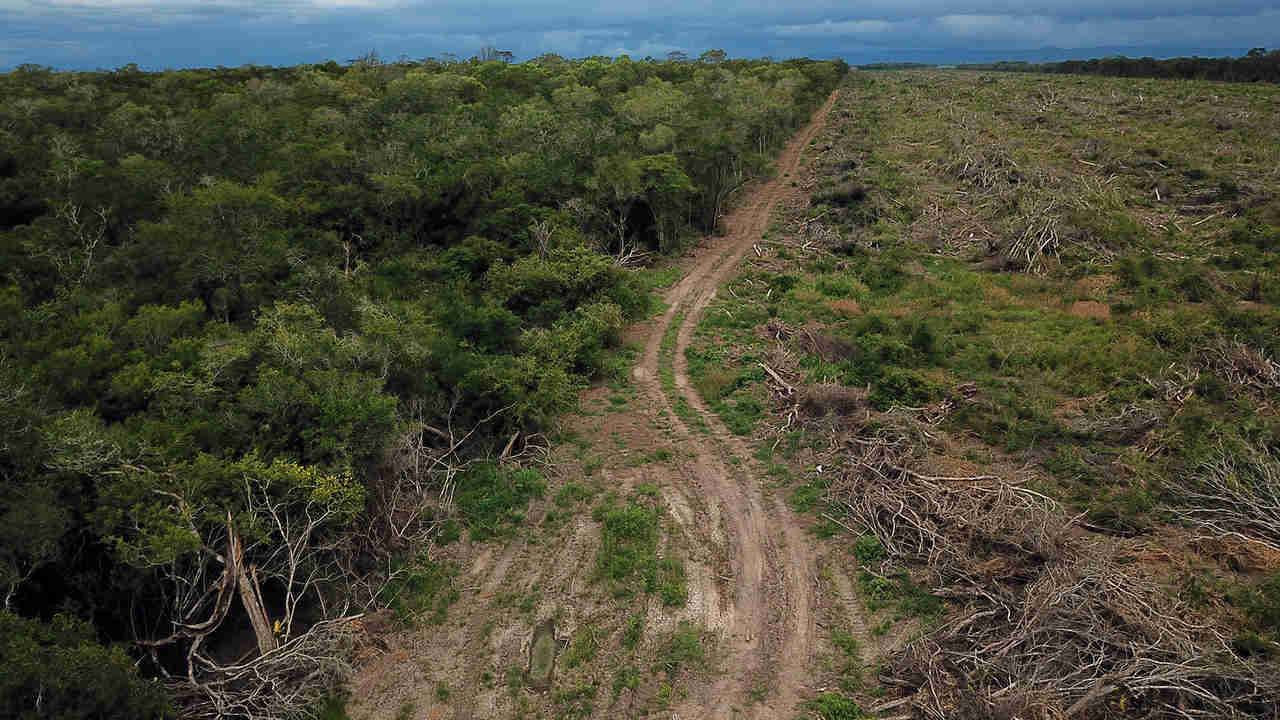 Forest in the transition zone between chaco and cerrado biomes being cleared for soybeans. Photo by Rhett A. Butler.[/caption] At climate talks in Madrid in December,
Norway, Germany and Britain committed up to $366 million over five years to help Colombia reduce deforestation
. Over 80 percent of the money is coming from Norway.
Forest in the transition zone between chaco and cerrado biomes being cleared for soybeans. Photo by Rhett A. Butler.[/caption] At climate talks in Madrid in December,
Norway, Germany and Britain committed up to $366 million over five years to help Colombia reduce deforestation
. Over 80 percent of the money is coming from Norway.
Bolivia
In June, the municipality of Ixiamas established the 1.5 million hectare Bajo Madidi municipal protected area . The landscape includes savannas, wetlands, and rainforest in northwestern Bolivia that together with Madidi National Park in Bolivia and Tambopata National Reserve in Peru contributes to a protected area network covering 2.9 million hectares, according to the Andes Amazon Fund which worked with the Wyss Campaign for Nature, Conservation International-Bolivia, and the Asociación Boliviana para la Investigación y Conservación de Ecosistemas Andino Amazónicos (ACEAA) to establish the protected area. In July, Bolivian President Evo Morales signed legislation that weakened restrictions on fire-setting and deforestation in the eastern lowlands. Once the dry season started, fires quickly burned out of control , especially in the Chiquitano forests that transition between the dry Chaco forest and the humid Amazon rainforest. Overall, an area of land larger than Costa Rica burned . Outrage over fires — and the slowness of Morales to respond — provoked large-scale protests that contributed to the president’s resignation.
Ecuador
In April a provincial court ruled that the Ecuadorian government could not auction the oil rights to traditional Waorani lands because the tribe had not been sufficiently consulted. The decision could affect auctions of oil blocks covering nearly 3 million hectares of indigenous territories.
Mesoamerica
Mexico’s
indigenous Lacandon continue to battle settlers
in the last remaining tropical rainforest in North America. Deforestation in Laguna del Tigre
, Guatemala’s largest national park, appeared to surge this year according to data from Global Forest Watch.
Forest clearing also seems to be on the rise in Río Plátano Biosphere Reserve
in Honduras.
Drug traffickers
— who clear land to establish cattle ranches as a mechanism for money laundering — are reported to be a factor in both parks. [caption id=“attachment_7851091” align=“alignnone” width=“1000”]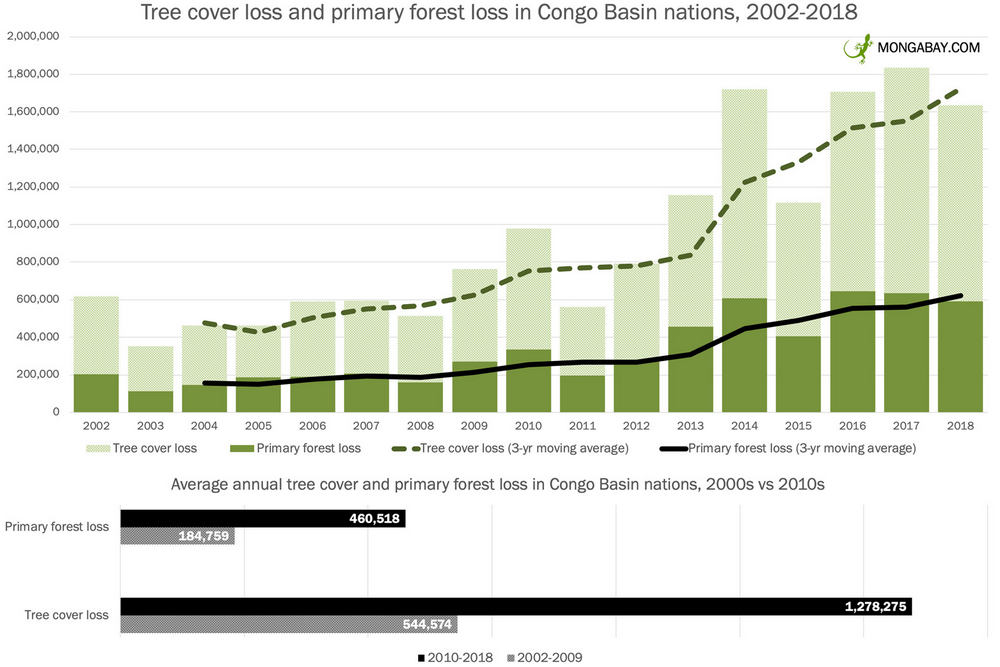 Tree cover loss and primary forest loss in Congo Basin countries (Democratic Republic of the Congo, Republic of Congo, Cameroon, Equatorial Guinea, Gabon, and Central African Republic) from 2002 to 2018 according to data from Hansen et al 2019.[/caption] At COP25 climate talks in Madrid, the governments of all eight members of the Central American Commission for Environment and Development (CCAD) — Belize, Costa Rica, the Dominican Republic, El Salvador, Guatemala, Honduras, Nicaragua, and Panama — proposed
the 5 Great Forests Initiative to protect and restore the five large remaining forests in Central America
. Under the plan, the countries would end all illegal cattle ranching within the forests; work to ensure that no wildlife species in the great forests goes extinct; and improve the livelihoods of forest-dependent peoples. The 5 Great Forests initiatives covers 10 million hectares.
Tree cover loss and primary forest loss in Congo Basin countries (Democratic Republic of the Congo, Republic of Congo, Cameroon, Equatorial Guinea, Gabon, and Central African Republic) from 2002 to 2018 according to data from Hansen et al 2019.[/caption] At COP25 climate talks in Madrid, the governments of all eight members of the Central American Commission for Environment and Development (CCAD) — Belize, Costa Rica, the Dominican Republic, El Salvador, Guatemala, Honduras, Nicaragua, and Panama — proposed
the 5 Great Forests Initiative to protect and restore the five large remaining forests in Central America
. Under the plan, the countries would end all illegal cattle ranching within the forests; work to ensure that no wildlife species in the great forests goes extinct; and improve the livelihoods of forest-dependent peoples. The 5 Great Forests initiatives covers 10 million hectares.
Africa
Congo Basin nations
Deforestation remain on an upward trend in the Congo Basin, driven by increased clearing in the Democratic Republic of Congo (DRC) and Cameroon as well as expansion of logging road networks , which grant access to remote forest areas, across the region. Work on a major road project that would link Cameroon and the Republic of Congo continued despite concern on the impact on forests and wildlife. In early 2019, Reuters broke the news that Former DRC President Joseph Kabila in December 2018 awarded an oil drilling license inside Salonga National Park, a UNESCO world heritage site. Republic of Congo opened Nouabalé-Ndoki National Park to oil exploration , but also secured $65 million in funding for forest conservation from the Central African Forest Initiative. The contrast between the policy developments was difficult for critics to digest. Despite ongoing political turmoil, Gabon secured up to $150 million from Norway for maintaining a low deforestation rate over the next ten years. While Gabon has been heralded in conservation sectors for its commitment to establishing protected areas, the country has seen increased interest from the agribusiness sector for industrial plantations . DRC’s Virunga National Park reopened to visitors again after 8-month closure due to violence, including the killing of seven park rangers. BuzzFeed investigated allegations that conservation rangers trained by WWF committed atrocities against suspected poachers and community members in Cameroon and DRC. Several reports highlighted rising deforestation in Cameroon due to rubber , palm oil , and charcoal . Although a deforestation ban implemented in December 2018 by rubber supply group Halcyon Agri on a concession controlled by its subsidiary Sudcam in Cameroon seems to be holding. A study published in Nature Climate Change reported the dry season in the Congo rainforest is getting longer and more intense , raising concerns about the future of the ecosystem.
Madagascar
Andry Rajoelina took over as Madagascar’s president in January. Given the environmental carnage that occurred during his first stint in power, which followed a 2009 coup d’état,
conservationists expressed deep concern
about the fate of the island nation’s fast-disappearing forests and increasing threatened wildlife. But so far Rajoelina’s administration has surprised the conservation community by
calling for international assistance in combatting forest fires
, laying out
an ambitious reforestation plan
, and withdrawing its request to CITES to sell its rosewood stocks. The president is said to be considering conservation priorities laid out in a resolution put forth by the Association of Tropical Biology and Conservation (ATBC) at a meeting Madagascar hosted in July. [caption id=“attachment_7851111” align=“alignnone” width=“1280”]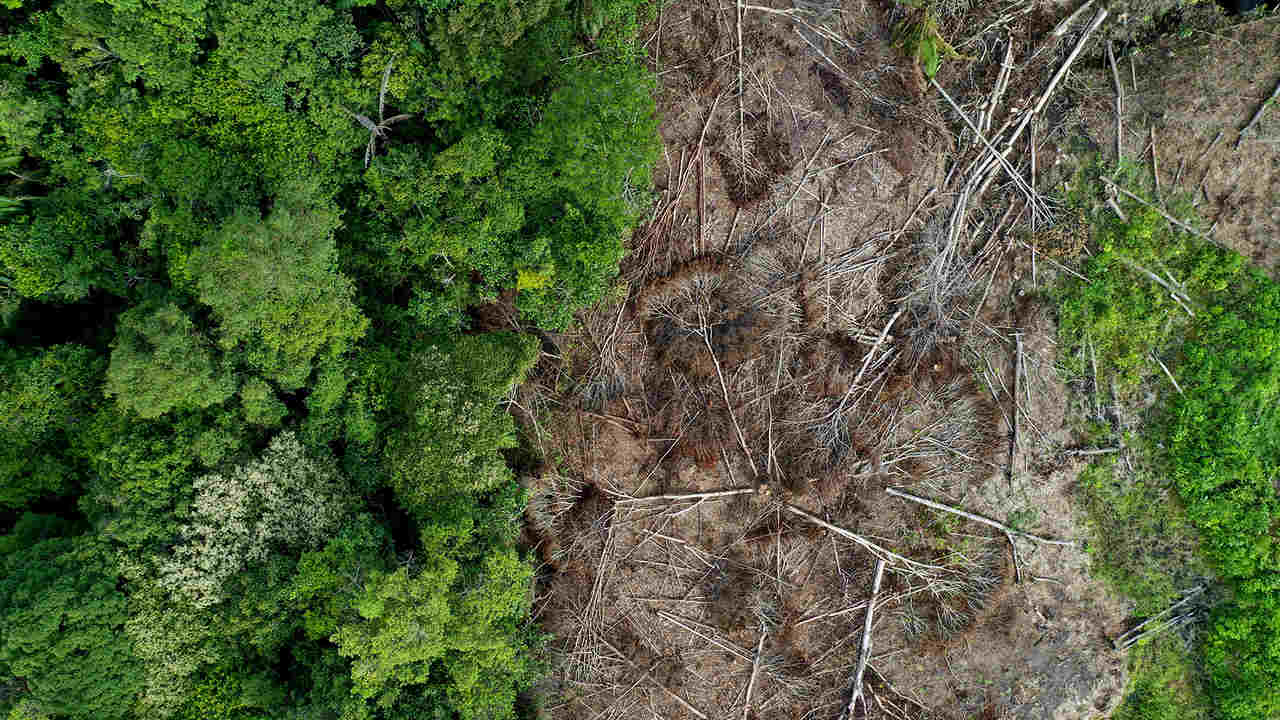 Deforestation in Kapuas Hulu, Indonesian Borneo. Photo by Rhett A. Butler.[/caption]
Deforestation in Kapuas Hulu, Indonesian Borneo. Photo by Rhett A. Butler.[/caption]
Asia-Pacific and Australia
Indonesia
Indonesia and Norway agreed on a first performance-based payment from a $1 billion REDD+ deal
signed back in 2010. It took nearly a decade to Indonesia to work out the legislative and policy frameworks to make the deal a reality. The Indonesian military took over construction of the controversial Trans Papua road
, which will cut through Lorentz National Park, a UNESCO World Heritage Site. In December 2018, 19 construction workers were killed working on the project, which has exacerbated tensions in the region and raised concerns about increased deforestation and social conflict. Joko Widodo, popularly known as Jokowi, was re-elected as president of Indonesia. Siti Nurbaya Bakar stayed on as Environment and Forestry Minister, but
activists expressed concern that some of the new cabinet members were associated with oligarchs, political elites, and the national security apparatus
, and would therefore push for weakening environmental protections and increasing investment in plantations, mining, and energy crops. In March a senior Indonesian minister warned that
Indonesia might pull out of the Paris climate accord
if the European Union moved to phase out incentives for palm oil-based biofuels. Critics noted that such a move would be self-defeating given the projected impacts of ongoing deforestation and climate change on the country. Indonesia seemed to change tactics later in the year when
it announced a plan to create a new palm oil agency to conduct audits of its palm oil certification scheme
in an effort to boost the reputation of the product. In December, Indonesia moved forward with
a World Trade Organization lawsuit against the E.U.
over its proposed phase out of palm oil-based biofuel due to environmental concerns. [caption id=“attachment_7851131” align=“alignnone” width=“1280”]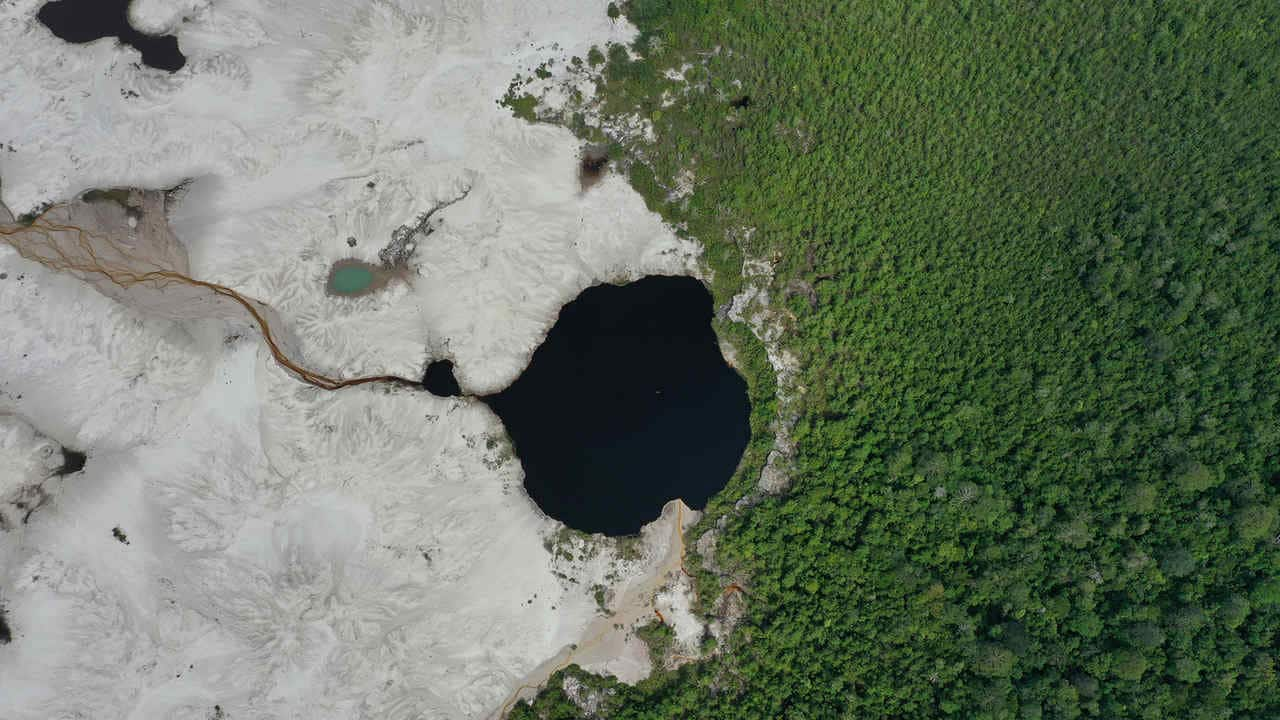 Forest cleared for gold mining in Indonesian Borneo. Photo by Rhett A. Butler[/caption] Authorities seized more than 400 containers of illegally logged timber from Maluku and Papua in a five-month period
exacerbating concerns about the country’s SVLK timber certification scheme
. SVLK is the system the E.U. relies upon to verify timber imports from Indonesia are legal. Indonesia published its
first ever map of customary forests
as part of a constitutional court mandated process to recognize traditional land claims. The map identifies some 470,000 hectares of untitled land as hutan adat, or customary forests used or claimed by indigenous communities. But indigenous rights group expressed disappointment over the slowness of the process. AMAN, the largest alliance of indigenous peoples in Indonesia, has said up to 40 million hectares of land in Indonesia could be classified as customary forest. The government puts the figure much lower. The controversial
Batang Toru dam
, which scientists say
puts the survival of the world’s most recently discovered ape
in jeopardy, the Tapanuli orangutan, remained in the headlines throughout 2019. Backers of the dam, including the Indonesian government, continued to make a case for the project, but interest from mainstream financiers waned as concerns about the project continued to mount. A scandal emerged when
a researcher claimed his signature was forged in a document used to obtain a permit for the dam
**.
Activists say dam proponents are using heavy-handed tactics against critics
**, a concern that gained wider attention after
the suspicious death of Golfrid Siregar
, a 34-year-old environmental activist and legal aide who was involved in a lawsuit against the project. Jokowi’s administration made a national moratorium on forest-clearance permanent
, but observers noted that the moratorium’s many loopholes have allowed deforestation to persist at high levels since it was first established in 2011. Jokowi announced Indonesia would move its capital from Jakarta to East Kalimantan, on the island of Borneo. Environmentalists immediately expressed concern about increased deforestation and just a few months later, wildfires were spotted burning at the site of the new capital, which was “
chosen in part because it was believed to be at low risk from fires and other disasters
“. A provincial court in Central Kalimantan
fined a subsidiary of palm oil giant Musim Mas Group $18.5 million
for fires that burned on its concession in Kalimantan in 2015. But there are doubts the government will ultimately collect the money, given that only $5.5 million of $223 million in judgments have been collected since 2015. Indonesia’s Supreme Court held the government liable for the 2015 fires
that burned hundreds of thousands of hectares of forest and peatlands. The court ordered the government to take steps to mitigate forest fires. The ruling came down as fires began to burn in Sumatra and Kalimantan. The fires went on to burn for months
. While initial analysis concluded that
most of the fires burned scrub and degraded areas
, rather than healthy rainforests, because they burned on peatlands, they are thought to have
released twice as much carbon as this year’s fires in the Amazon
.
Jokowi called the fires a national embarrassment
and the World Bank estimated
economic losses from the fires at $5.2 billion
. Rainforest Action Network and Greenpeace released damning reports that linked international consumer products companies to egregious forest destruction for palm oil production. RAN looked specifically at
deforestation in Sumatra’s Rawa Singkil Wildlife Reserve
, while Greenpeace tied
Mondelēz, Nestlé, Unilever, Procter & Gamble, Wilmar and Cargill to 2019 fires on peatlands
. A report from MapHubs, an open-data platform and technology company that monitors natural resources, showed that
orangutan habitat is being cleared around palm oil mills
on the island of Borneo. These mills supply a number of companies that have made zero deforestation commitments. The
Forest Stewardship Council (FSC) released a set of heavily redacted reports on violations by Korindo
in Papua, on the island of New Guinea. What made the documents notable was Korindo issued a cease-and-desist letter to stop their publication, a highly unusual move. Activists say Korindo has cleared more than 50,000 hectares of rainforest in Papua. CIFOR released the
Papua Atlas
, which tracks developments in the forests of Indonesian New Guinea.
Forest cleared for gold mining in Indonesian Borneo. Photo by Rhett A. Butler[/caption] Authorities seized more than 400 containers of illegally logged timber from Maluku and Papua in a five-month period
exacerbating concerns about the country’s SVLK timber certification scheme
. SVLK is the system the E.U. relies upon to verify timber imports from Indonesia are legal. Indonesia published its
first ever map of customary forests
as part of a constitutional court mandated process to recognize traditional land claims. The map identifies some 470,000 hectares of untitled land as hutan adat, or customary forests used or claimed by indigenous communities. But indigenous rights group expressed disappointment over the slowness of the process. AMAN, the largest alliance of indigenous peoples in Indonesia, has said up to 40 million hectares of land in Indonesia could be classified as customary forest. The government puts the figure much lower. The controversial
Batang Toru dam
, which scientists say
puts the survival of the world’s most recently discovered ape
in jeopardy, the Tapanuli orangutan, remained in the headlines throughout 2019. Backers of the dam, including the Indonesian government, continued to make a case for the project, but interest from mainstream financiers waned as concerns about the project continued to mount. A scandal emerged when
a researcher claimed his signature was forged in a document used to obtain a permit for the dam
**.
Activists say dam proponents are using heavy-handed tactics against critics
**, a concern that gained wider attention after
the suspicious death of Golfrid Siregar
, a 34-year-old environmental activist and legal aide who was involved in a lawsuit against the project. Jokowi’s administration made a national moratorium on forest-clearance permanent
, but observers noted that the moratorium’s many loopholes have allowed deforestation to persist at high levels since it was first established in 2011. Jokowi announced Indonesia would move its capital from Jakarta to East Kalimantan, on the island of Borneo. Environmentalists immediately expressed concern about increased deforestation and just a few months later, wildfires were spotted burning at the site of the new capital, which was “
chosen in part because it was believed to be at low risk from fires and other disasters
“. A provincial court in Central Kalimantan
fined a subsidiary of palm oil giant Musim Mas Group $18.5 million
for fires that burned on its concession in Kalimantan in 2015. But there are doubts the government will ultimately collect the money, given that only $5.5 million of $223 million in judgments have been collected since 2015. Indonesia’s Supreme Court held the government liable for the 2015 fires
that burned hundreds of thousands of hectares of forest and peatlands. The court ordered the government to take steps to mitigate forest fires. The ruling came down as fires began to burn in Sumatra and Kalimantan. The fires went on to burn for months
. While initial analysis concluded that
most of the fires burned scrub and degraded areas
, rather than healthy rainforests, because they burned on peatlands, they are thought to have
released twice as much carbon as this year’s fires in the Amazon
.
Jokowi called the fires a national embarrassment
and the World Bank estimated
economic losses from the fires at $5.2 billion
. Rainforest Action Network and Greenpeace released damning reports that linked international consumer products companies to egregious forest destruction for palm oil production. RAN looked specifically at
deforestation in Sumatra’s Rawa Singkil Wildlife Reserve
, while Greenpeace tied
Mondelēz, Nestlé, Unilever, Procter & Gamble, Wilmar and Cargill to 2019 fires on peatlands
. A report from MapHubs, an open-data platform and technology company that monitors natural resources, showed that
orangutan habitat is being cleared around palm oil mills
on the island of Borneo. These mills supply a number of companies that have made zero deforestation commitments. The
Forest Stewardship Council (FSC) released a set of heavily redacted reports on violations by Korindo
in Papua, on the island of New Guinea. What made the documents notable was Korindo issued a cease-and-desist letter to stop their publication, a highly unusual move. Activists say Korindo has cleared more than 50,000 hectares of rainforest in Papua. CIFOR released the
Papua Atlas
, which tracks developments in the forests of Indonesian New Guinea.
Myanmar
Karen indigenous communities in Myanmar launched the 548,500-hectare (1.4 million acre) Salween Peace Park in Kayin State. The protected area encompasses more than 340 villages, 27 community forests, four forest reserves, and three wildlife sanctuaries.
Malaysia
Work continued on the Pan Borneo Highway in the Malaysian states of Sabah and Sarawak. Environmentalists and scientists are trying to persuade the government to shift the path of a section of highway so it won’t cut through an elephant-dense tract of protected forest. Malaysia’s stand-off with the E.U. prompted its Minister of Primary Industries Teresa Kok to tell Bloomberg that the country was considering capping its palm oil estate at 6 million hectares (14.8 million acres), an area only 150,000 hectares than what’s current planted. Kok said that Malaysia could continue to increase palm oil production despite the cap by improving yields of existing plantations. The move would help boost the reputation of Malaysian palm oil, which has been sullied by the industry’s large-scale destruction of rainforests and peatlands in recent decades. The impact of rising demand for durian on Malaysia’s forests attracted some attention from the press.
Papua New Guinea
Logging, mining, and agribusiness companies
set their sites on Woodlark Island
, an island off eastern New Guinea that’s home to an array of unique species. The logging company aims to clear at least 40 percentof the island’s tree cover, while a mining company hopes to establish an open pit gold mine. A previous effort to log the island was stopped in 2007 after global outcry. Maxland, a Malaysian timber company,
continued to clear primary forest on Manus Island
, ostensibly for a 125-square-kilometer (48-square-mile) rubber plantation. An analysis found that
PNG’s comprehensive environmental laws aren’t well enforced
, putting its forests at risk and disadvantaging traditional communities. [caption id=“attachment_7851121” align=“alignnone” width=“1280”]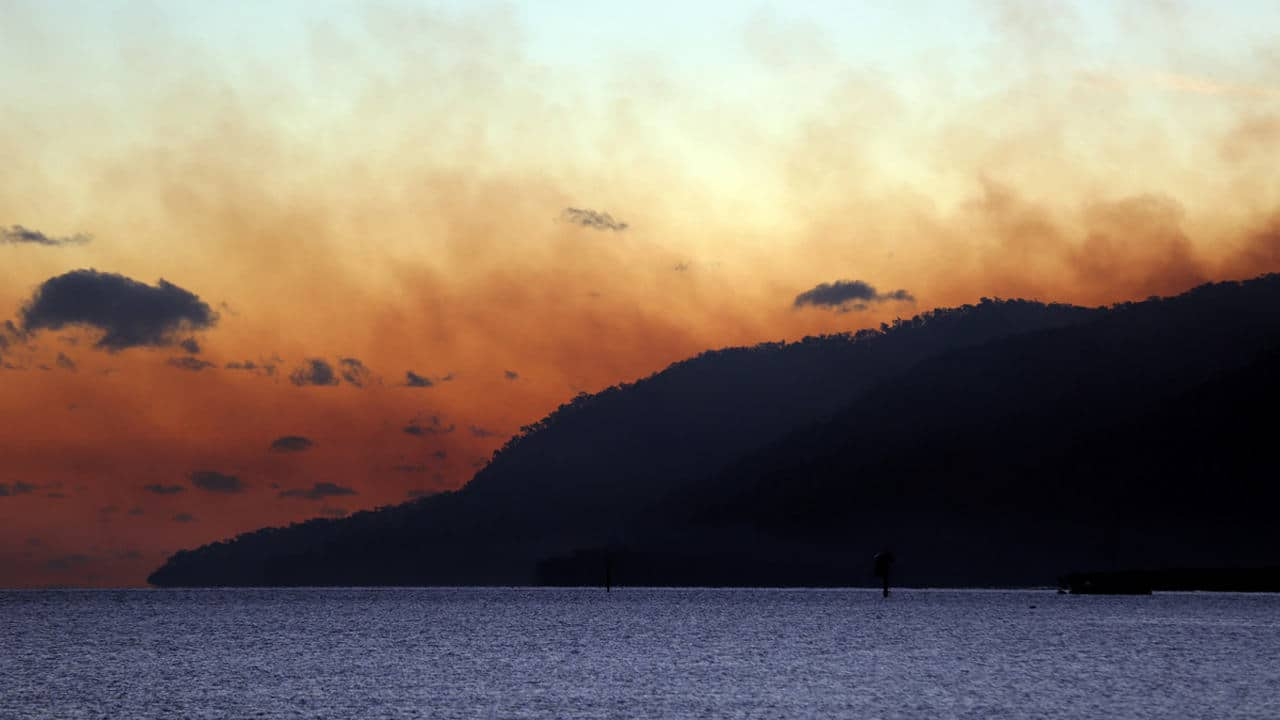 Fires in Far North Queensland, Australia in 2014. Photo by Rhett A. Butler.[/caption]
Fires in Far North Queensland, Australia in 2014. Photo by Rhett A. Butler.[/caption]
Australia
In March, more than 300 scientists called for action against surging deforestation across Australia . They pointed to the weakening of forest protection laws as a key factor in soaring deforestation in New South Wales and Queensland. The board of the Wet Tropics Management Authority, which works to protect the UNESCO World Heritage rainforest in north Queensland, issued a dire statement in April that the region’s rainforest was in “accelerating decline” due to deforestation, degradation, and the impacts of climate change. The board noted Australia’s tropical rainforests faced greater risk of fire. Those fears became realiity in August 2019 when fires started to burn across wide swathes of the East coast of Australia . By the third week in December, some three million hectares of land had burned across the country, including old-growth forests. 20 percent of the Blue Mountains world heritage area went up in flames.
Consumption
Researchers writing in the journal Global Environmental Change argued that
a shift away from meat and dairy production to plant-based alternatives could curb demand for agricultural land by 11 percent worldwide
, reducing pressure on forests and other ecosystems. A senior executive at Nestlé said
humankind will need to cut down on meat consumption
if it hopes to address issues like deforestation and environmental degradation. Laurent Freixe, Executive Vice President and head of operations in the Americas, said public awareness on these issues is growing in markets beyond Western Europe and North America. [caption id=“attachment_7851211” align=“alignnone” width=“1280”]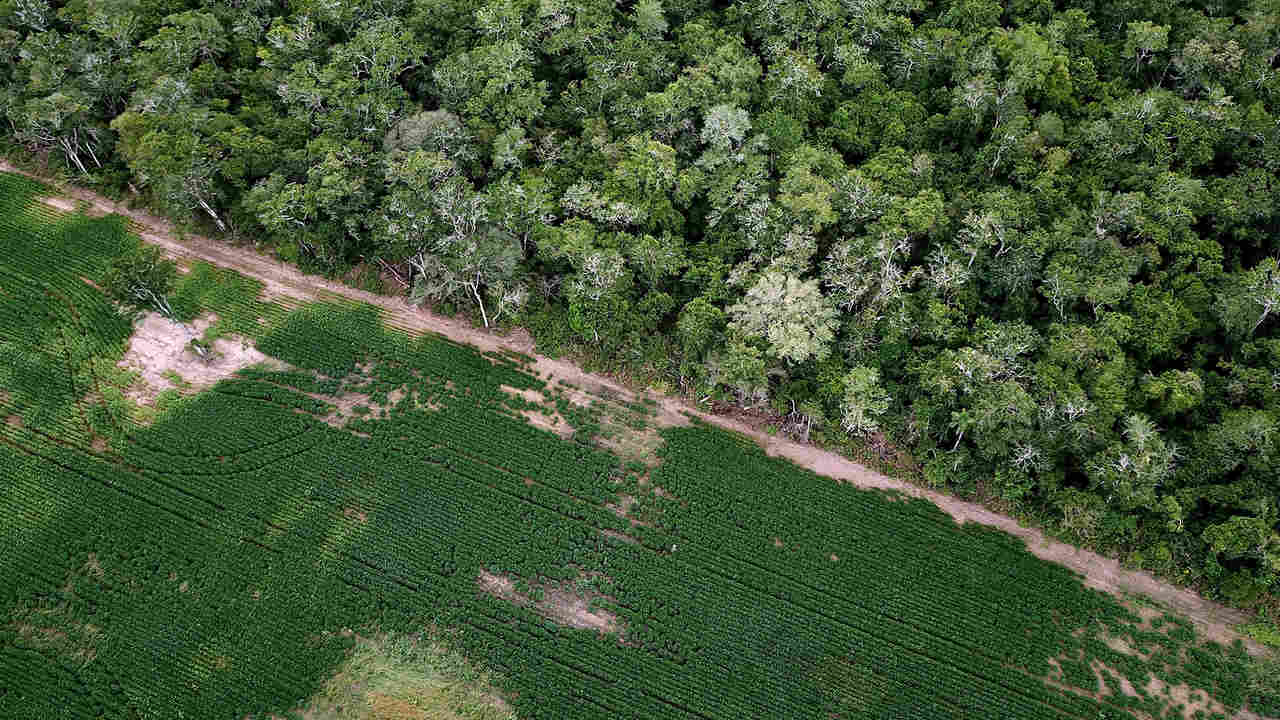 Soy and Chaco forest in Bolivia. Photo by Rhett A. Butler[/caption]
Soy and Chaco forest in Bolivia. Photo by Rhett A. Butler[/caption]
Little progress on Zero Deforestation policies
At the World Economic Forum in January, COFCO Corporation, China’s largest food processor, announced support for extending the Amazon soy moratorium to other forest and savannah regions of South America, including the Cerrado and the Chaco. It was an unusual public statement for a state-owned company in China. Several NGO reports warned that companies and governments are falling short on their pledges to reduce deforestation . In a survey of 66 Consumer Goods Forum (CGF) member companies , Greenpeace found that not a single one could demonstrate “meaningful effort to eradicate deforestation from its supply chain.” With much fanfare in 2010, CGF established a zero net deforestation by 2020 target. CGF pushed back on the criticism . A set of commitments under the 2014 New York Declaration on Forests to halve deforestation by 2020 and end it by 2030 are also being missed. Deforestation has risen substantially since the declaration was signed and several high-profile companies have been back-peddling on their zero deforestation commitments, with some reverting to business-as-usual approaches through subsidiaries and third party suppliers. Zoological Society of London released an analysis that concluded forestry companies lack adequate safeguards for the holdings they control, leading to deforestation and forest degradation instead of sustainable forest management. Rainforest Action Network found major Asian banks have provided $60 billion in finance over the past five years to companies associated with deforestation in Southeast Asia.
A study conducted by the Stockholm Environment Institute (SEI) and Global Canopy’s Trase platform estimated that nearly 400,000 hectares of forest cleared in the Brazilian Amazon between 2006 and 2017 is now planted with soy **.** Nestlé announced 77 percent of its agricultural commodities are ‘deforestation-free’ . In July, Unilever updated its zero deforestation policy and published a list of its soy, paper, and packaging product suppliers. After quietly revising its forest conservation policy to exclude third party suppliers from its zero deforestation commitment last year, Asia Pulp & Paper (APP) continued to source timber from PT Fajar Surya Swadaya and PT Silva Rimba Lestari , which NGOs report cleared 32,000 hectares of forests in East Kalimantan between 2013 and 2017 . APP’s competitor APRIL is also sourcing from the suppliers. After research showed that Brazilian meatpacking giant JBS circumvented the Amazon cattle agreement by continuing to buy from ranchers who illegally cleared forests, the company moved to conceal information about its supply chain and sourcing practices .
Palm oil
In 2019 palm oil prices remained low relative to the past decade, though there was a run-up in the price at the end of the year. Low prices dampened enthusiasm for developing marginal projects, but palm oil does remain the most profitable form of agricultural land use in much of the tropics, so forests and peatlands continued to be converted for plantations. The biggest palm oil story of the year was the dispute between the European Union and palm oil producers Malaysia and Indonesia over the European Commission’s criteria for sustainable biofuels. In March,
the European Commission effectively limited use of palm oil in its renewable fuels standard
due the emissions generated by conversion of rainforests and peatlands to oil palm plantations. Despite intense lobbying by the palm oil sector and the Malaysian and Indonesian governments, most palm oil-based biodiesel now does not qualify as a low emissions biofuel in Europe. Malaysia and Indonesia reacted angrily to the decision, with Indonesia threatening to pull out of the Paris climate accord and later filing a World Trade Organization lawsuit against the E.U. Malaysia said it would take steps to improve the environmental performance of its domestic palm oil production, including
announcing it would allow plantation maps to be made public
, a move that could boost the Roundtable on Sustainable Palm Oil (RSPO), a certification body. [caption id=“attachment_7851231” align=“alignnone” width=“1000”]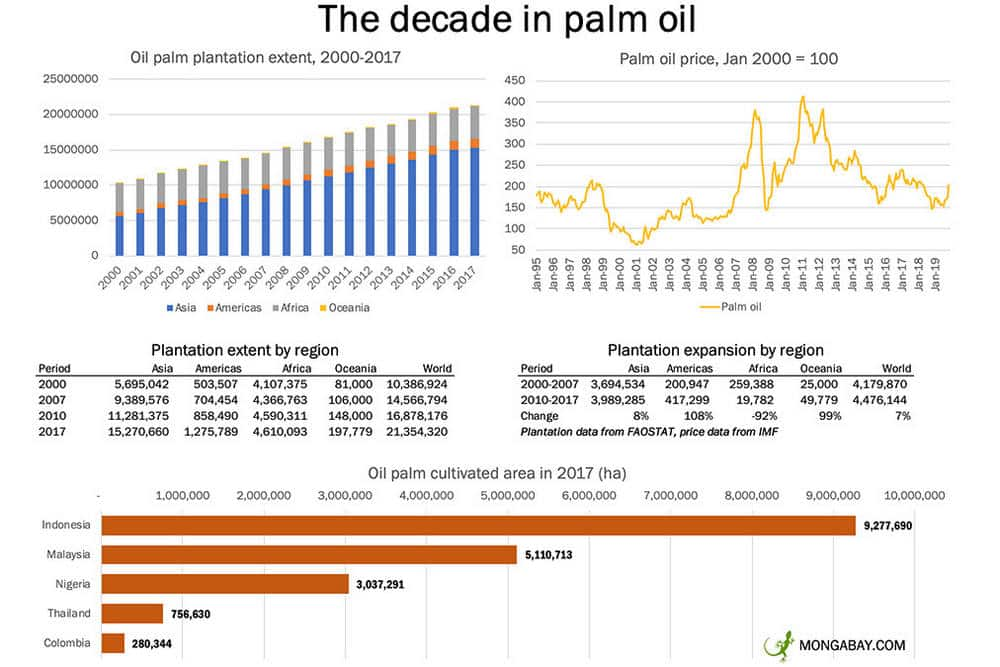 Palm oil in a decade.[/caption] A study published in World Development found that conversion of forests to oil palm plantations has mixed benefits for local communities in Borneo, with
forest-dependent communities seeing the least upside from palm oil
, including a drop in relative economic well-being. CIFOR published a report that
attributed 39 percent of forest loss in Borneo since 2000 to palm oil
. Rainforest Foundation Norway warned that
the aviation industry’s proposed shift toward biofuels could drive deforestation
for feedstocks like soy and palm oil. BlackRock, the world’s largest fund manager,
found itself under fire for its investments in sectors that drive deforestation
, including palm oil in Southeast Asia and agribusiness in the Amazon.
Palm oil in a decade.[/caption] A study published in World Development found that conversion of forests to oil palm plantations has mixed benefits for local communities in Borneo, with
forest-dependent communities seeing the least upside from palm oil
, including a drop in relative economic well-being. CIFOR published a report that
attributed 39 percent of forest loss in Borneo since 2000 to palm oil
. Rainforest Foundation Norway warned that
the aviation industry’s proposed shift toward biofuels could drive deforestation
for feedstocks like soy and palm oil. BlackRock, the world’s largest fund manager,
found itself under fire for its investments in sectors that drive deforestation
, including palm oil in Southeast Asia and agribusiness in the Amazon.
Cocoa
The spotlight was on the cocoa sector
in 2019,
pressuring cacao producers and buyers to commit to reducing their environmental footprint
. In March, Côte d’Ivoire (Ivory Coast), Ghana, and several major chocolate and cocoa companies released action plans to end deforestation under the Cocoa & Forests Initiative, which launched in November 2017 at the UN Climate Change Conference in Bonn, Germany. Mars, Mondelēz, Olam, and Nestlé were among the companies to establish zero deforestation policies for their supply chains. Improving the sustainability of cocoa will require a substantial overhaul of the current system. For example, the
Washington Post
found “significant lapses” in the compliance review process of Utz, the world’s largest verifier of certified cocoa. Utz had certified nearly 5,000 farms that operated in protected areas in Côte d’Ivoire. [caption id=“attachment_7851241” align=“alignnone” width=“1280”]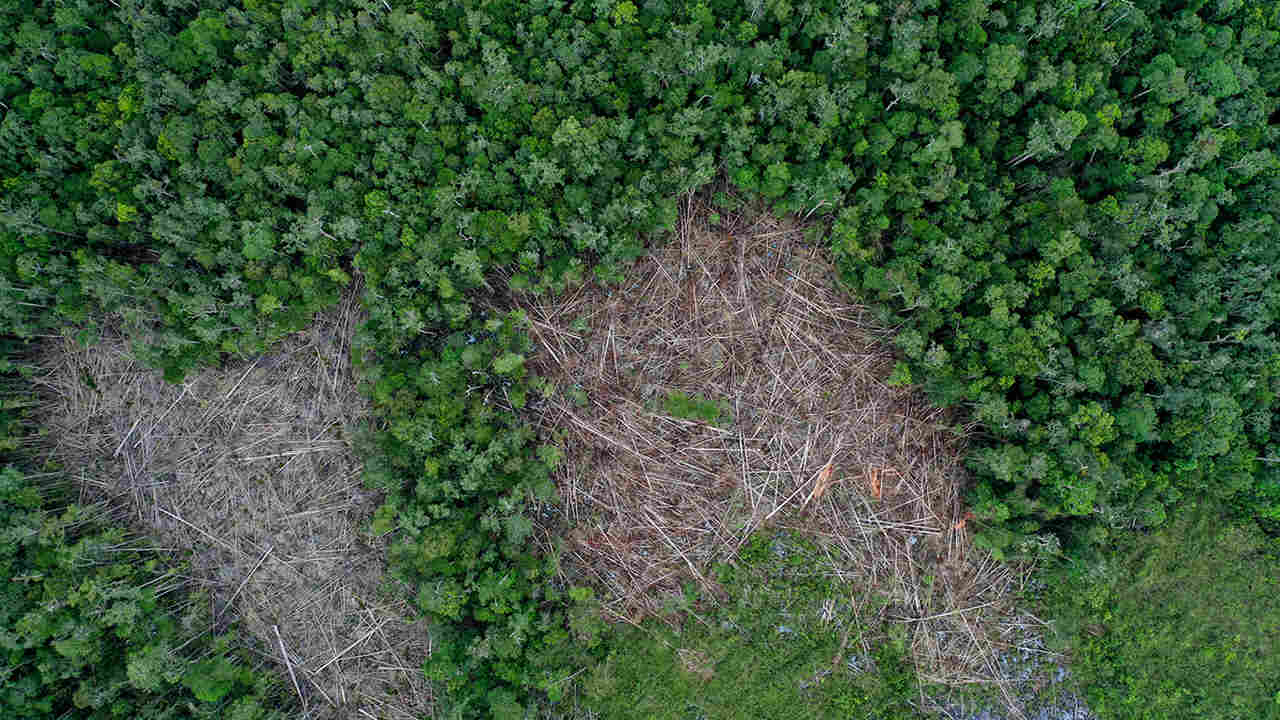 Deforestation in Borneo. Photo by Rhett A. Butler[/caption] The involvement of big cocoa companies also raised concerns among some groups in Côte d’Ivoire, who warned that the country’s new forestry code increases the risk cocoa poses to West African forests, potentially allowing the conversion of “degraded” protected forests and community agroforestry plots to cacao farms managed by international companies.
Deforestation in Borneo. Photo by Rhett A. Butler[/caption] The involvement of big cocoa companies also raised concerns among some groups in Côte d’Ivoire, who warned that the country’s new forestry code increases the risk cocoa poses to West African forests, potentially allowing the conversion of “degraded” protected forests and community agroforestry plots to cacao farms managed by international companies.
United States and tropical forests
In September, the California Air Resources Board voted 7-4 to approve the Tropical Forest Standard, a framework for allowing entities in the state of California to “offset” some of their carbon emissions by supporting forest conversation projects in specific jurisdictions in tropical countries. The measure had been championed for years by supporters of Reducing Emissions from Deforestation and forest Degradation (REDD+), a U.N. mechanism for compensating tropical countries for conserving their forests, but faced opposition from some environmental and social justice groups that view offsets as letting polluters off the hook for their emissions. The Tropical Forest Standard includes a number of safeguards, but its critics aren’t convinced these will be enough to protect forests or their inhabitants. The Tropical Forest Standard could drive up to $1 billion in direct funding for tropical forests by 2030 and establish a model that could be followed by other states and countries. California lawmakers failed to pass California Deforestation Free Procurement Act (AB 572), legislation that would have required the state to implement a zero deforestation procurement policy for “forest-risk commodities” like palm oil, paper, timber, rubber, soy, and beef. The bill died in committee. Norway has already enacted such a policy. Donald Trump’s trade war with China helped drive up the price of Brazilian soybeans, prompting fears of increased deforestation in the Amazon and beyond. A four-year investigation by the Environmental Investigation Agency (EIA) found evidence that products made from endangered African hardwoods have been illegally sold in hardware stores across the United States . The U.S. government launched an investigation into the U.S. importers of the wood, Evergreen Hardwoods and Cornerstone Forest Products, under the Lacey Act. Environmentalists’ long-standing push to convince people to eat less meat seemed to gain traction in 2019, with a surge in interest in meat replacement options. Even fast-food chains like Burger King—with the Impossible Whopper—jumped on the bandwagon.
Europe and deforestation in the tropics
Europe’s role in driving deforestation garnered a lot of attention in 2019. One study calculated that
one-sixth of the carbon footprint of the average European’s diet can be directly linked to deforestation in tropical countries
. Palm oil, soybeans, beef,
timber
,
cocoa
, and rubber are the main culprits. Palm oil was again a major source of tension between Europe and major palm oil producers Indonesia and Malaysia.
France said it would stop ‘deforestation imports’ by 2030
through stricter sourcing guidelines for agricultural commodities most often associated with tropical forest clearing. [caption id=“attachment_7851281” align=“alignnone” width=“1280”]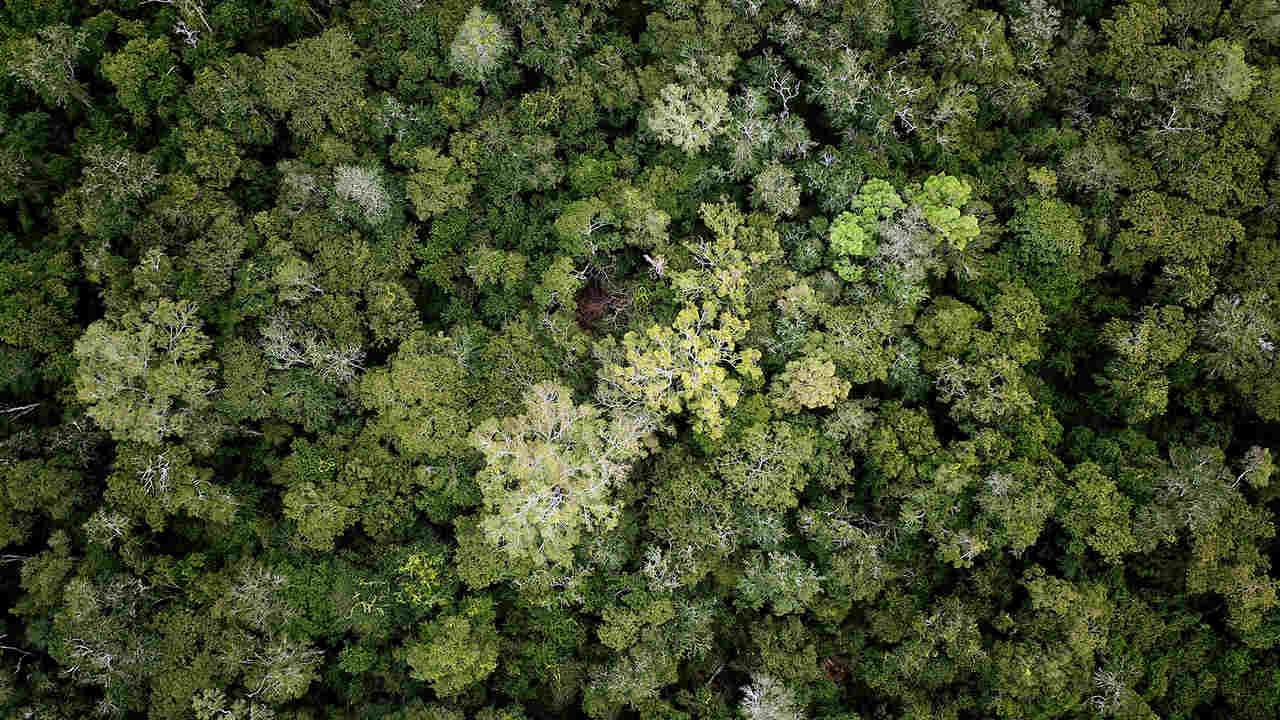 Forest in the Bolivian Amazon. Photo by Rhett A. Butler for Mongabay.[/caption] Norway saw 70 percent drop in consumption of palm oil-based biofuels
after the government banned purchases of such fuels in 2017 due their role in driving deforestation. Norway’s Government Pension Fund Global – the world’s largest sovereign wealth fund –
continued to divest from companies associated with deforestation
, dropping four plantation companies — Olam International, Halcyon Agri Corp, Sime Darby Plantation and Sipef — from its portfolio. A report from the Earthsight
revealed that major U.K. supermarket chains — including Sainsbury’s, Asda, Morrisons and Lidl — are still importing beef from Brazil’s largest meat producer, JBS, despite the company being implicated in corruption scandals and illegal deforestation.
Forest in the Bolivian Amazon. Photo by Rhett A. Butler for Mongabay.[/caption] Norway saw 70 percent drop in consumption of palm oil-based biofuels
after the government banned purchases of such fuels in 2017 due their role in driving deforestation. Norway’s Government Pension Fund Global – the world’s largest sovereign wealth fund –
continued to divest from companies associated with deforestation
, dropping four plantation companies — Olam International, Halcyon Agri Corp, Sime Darby Plantation and Sipef — from its portfolio. A report from the Earthsight
revealed that major U.K. supermarket chains — including Sainsbury’s, Asda, Morrisons and Lidl — are still importing beef from Brazil’s largest meat producer, JBS, despite the company being implicated in corruption scandals and illegal deforestation.
Other themes
Reforestation
Just in time for the start of the UN Decade on Ecosystem Restoration in 2021, interest in tree planting exploded in 2019. Jumping on the bandwagon were YouTube celebrities and Elon Musk, among pop culture icons, as well as tech companies and drone start-ups . But scientists urged caution , noting that tree-planting programs must be carefully conceived and executed to avoid adverse impacts on climate, biodiversity, and local communities. Regulators warned about tree-planting scams that are happy to take consumers’ money but don’t actually plant trees. The potential for reforestation is vast: A study published in Science Advances in July estimated that 101 million hectares (386,000 square miles) of deforested land across the tropics has high potential for restoration.
Conservation Technology
A paper published in Science
in January [disclosure: I was a co-author] argued that bioacoustic sensors
could improve the effectiveness of zero deforestation commitments
by functioning as an alert system and capturing data on biodiversity and forest health, providing more information than satellites alone. Bioacoustics is a fast-growing field in the conservation space. A research team in Brazil used LIDAR to discover the
Amazon’s tallest tree
, a red angelim, that stood 88.5 meters (just over 290 feet) tall. A similar approach in Malaysian Borneo discovered
the tallest tree in the tropics
–over 94 meters in height—in 2016. XPRIZE, an organization that has held more than a dozen competitions on topics ranging from spaceflight to oil cleanup over the past 25 years, established
a $10 million prize to support the development of technology that enables rapid assessment of rainforest biodiversity
. Scientists announced
a new approach to monitoring carbon emissions from deforestation
by using data from Planet’s constellation of satellites to scale up and extend measurements collected via airplane-based sensors. Planet data was also
used to analyze Amazon forest fires in near-real time
. The European Space Agency published
a new set of biomass maps that will improve monitoring of carbon emissions and sequestration across the world’s terrestrial ecosystems
. Mongabay’s conservation technology journalist
Sue Palminteri passed away at 54
. [caption id=“attachment_7851291” align=“alignnone” width=“1280”]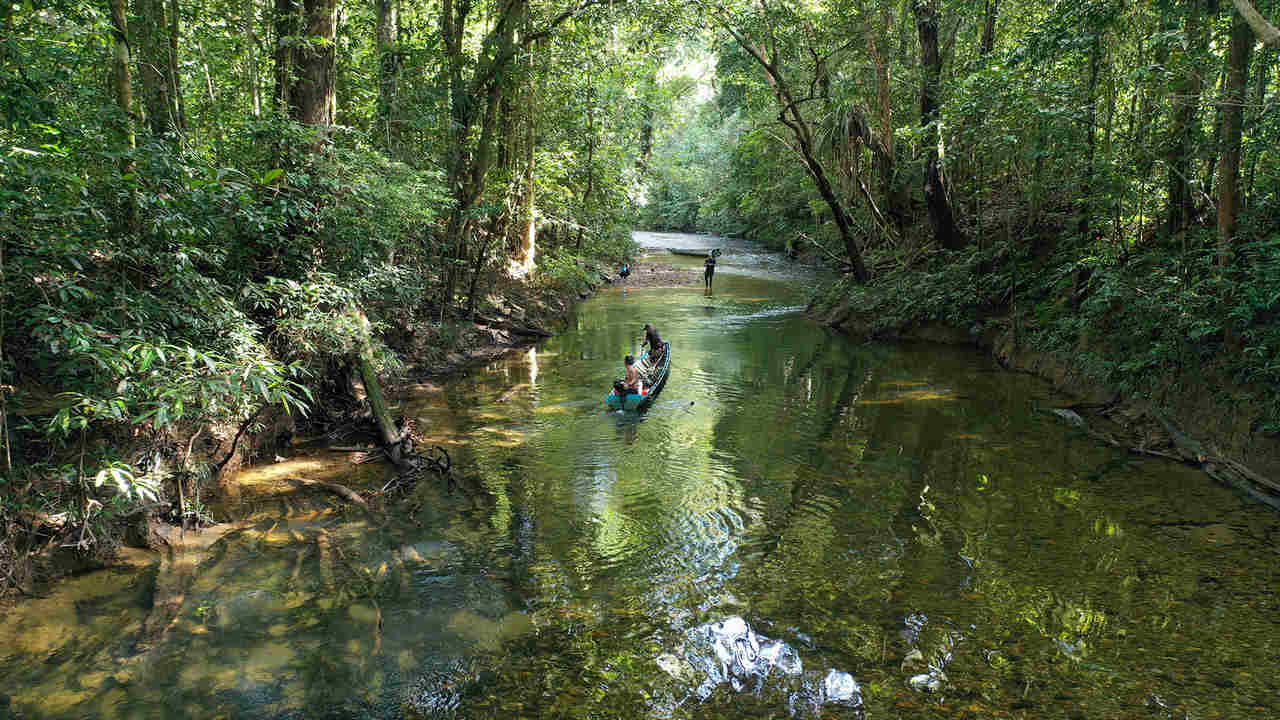 Dayak members of the Sungai Utik longhouse community in West Kalimantan. Photo by Rhett A. Butler[/caption]
Dayak members of the Sungai Utik longhouse community in West Kalimantan. Photo by Rhett A. Butler[/caption]
Rainforests and religion
In 2019 Pope Francis was vocal about the need to protect tropical forests and the indigenous peoples that inhabit them. During a visit to Madagascar, the pope urged the world to help the island nation to protect its forests, which are rapidly declining. In September, the U.N.’s Climate Action Summit launched the Faiths for Forests campaign to mobilize religious leaders to halt and reverse tropical deforestation. In early October , after the Amazon fire crisis, Pope Francis convened a synod – a meeting of bishops and priests – on the state of the Amazon rainforest . It was the first synod ever to discuss an ecosystem and at the end of the month, Catholic bishops from the Amazon region denounced “attacks” on the Amazon and its indigenous peoples .
Environmental defenders under threat
Violence against environmental defenders continued through 2019, spiking in December with a spate of murders of indigenous leaders in Brazil . According to a report from Global Witness , Latin America saw most murdered environmental defenders in 2018 with 83. A report from Human Rights Watch tied organized criminal groups to over 300 murders of environmental defenders in the Amazon.
Infrastructure
A report from RAISG, the Amazonian Geo-referenced Socio-Environmental Information Network, warned that
planned infrastructure across the Amazon could lock in decades of deforestation
and put indigenous territories and protected areas at risk. Another report, published by the Inter-American Dialogue and the Andes Amazon Fund, identified
a lack of adequate resources for oversight and enforcement of environmental regulations as a common factor
in deforestation across Amazon countries. Concerns about the impact of China’s Belt and Road Initiative on forests and other ecosystems — especially in Southeast Asia —
Scientific Reports
. Infrastructure is a major driver of habitat fragmentation. A study published in
Scientific Reports
found that the world’s natural habitats are being fragmented into ever smaller pieces. Roughly 56 percentof the planet’s terrestrial surface, excluding permanent ice and snow, has low human impact. [caption id=“attachment_7851311” align=“alignnone” width=“1280”]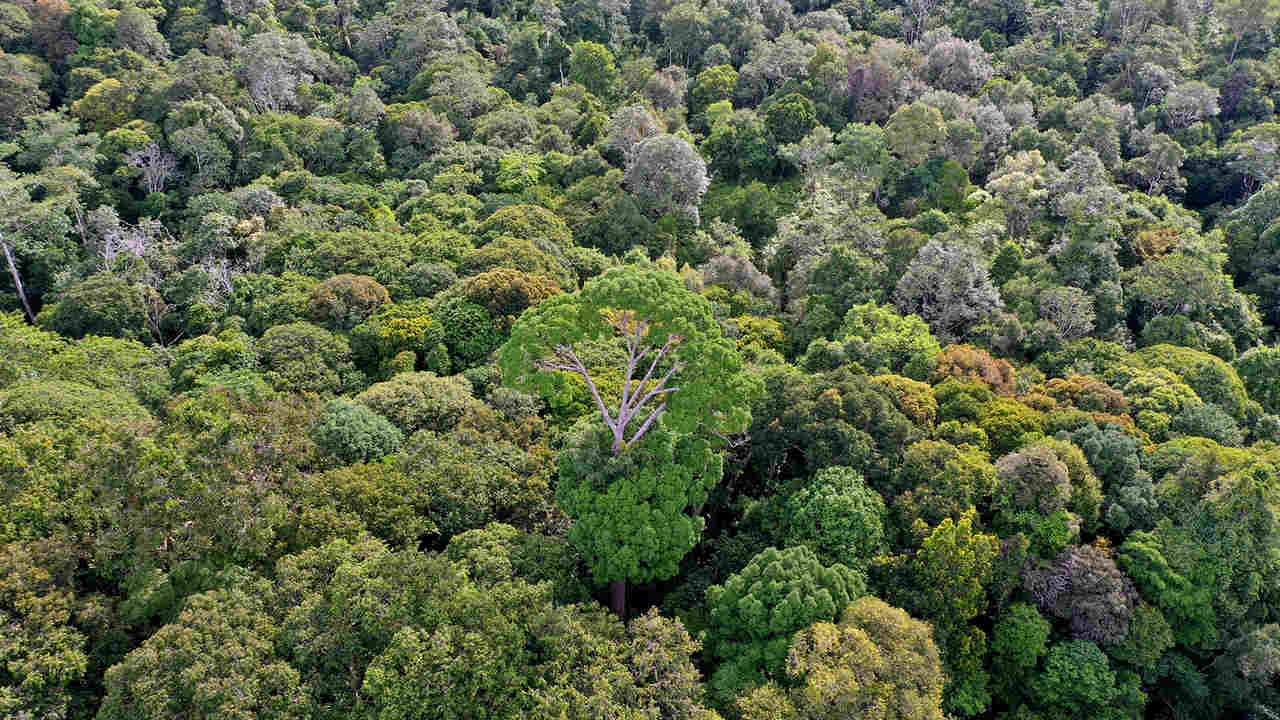 Intact rainforest in Indonesian Borneo. Photo by Rhett A. Butler.[/caption]
Intact rainforest in Indonesian Borneo. Photo by Rhett A. Butler.[/caption]
REDD+
In February
Brazil became the first country to receive payment from the Green Climate Fund
, a fund established by the U.N. to compensate tropical countries on a results basis for reducing deforestation.
The $96 million payment proved controversial
because it’s for reductions that occurred between 2014-2015. Deforestation is now sharply rising in Brazil and
policies enacted by President Jair Bolsonaro make it unlikely that Brazil will meet its obligations under the 2015 Paris Accord
. Ahead of California’s plan to vote on the Tropical Forest Standard
, ProPublica published
a stinging critique of Acre’s Reducing Emissions from Deforestation and forest Degradation (REDD+) program
, calling it “worse than nothing”. The piece highlighted the Paiter-Suruí project which received support from a number of prominent entities, ranging from Google to USAID, but was suspended last year due to a surge of illegal mining and logging in the tribe’s territory. The feature prompted pushback from groups like
Conservation International
and the
Environmental Defense Fund
that have been working to develop performance-based compensation for forest conservation projects. [caption id=“attachment_7851321” align=“alignnone” width=“1280”]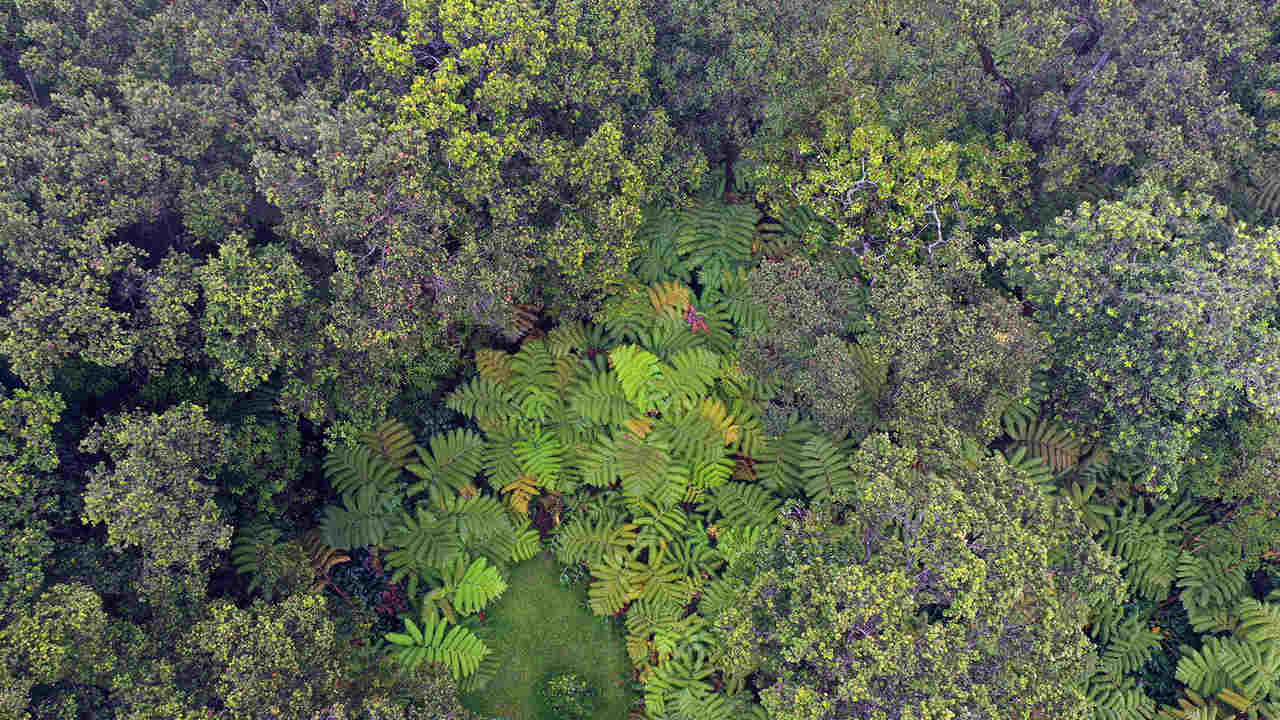 Forest canopy in Volcano on the big island of Hawaii in 2019. Photo by Rhett A. Butler[/caption] Shell announced it would invest $300 million in “natural ecosystem”
over three years. A study published in
Proceedings of the National Academy of Sciences
argued that a $250 million REDD+ agreement between Norway and Guyana
proved effective at reducing deforestation in the small South American country between 2010 and 2015
.
Forest canopy in Volcano on the big island of Hawaii in 2019. Photo by Rhett A. Butler[/caption] Shell announced it would invest $300 million in “natural ecosystem”
over three years. A study published in
Proceedings of the National Academy of Sciences
argued that a $250 million REDD+ agreement between Norway and Guyana
proved effective at reducing deforestation in the small South American country between 2010 and 2015
.
Biodiversity
Conservationists worldwide stepped up campaigning on biodiversity ahead of key 2020 meetings, including the Convention on Biological Diversity and the IUCN World Conservation Congress. 13 major conservation organizations called on world leaders to back a plan to protect 30 percent of the world’s surface and oceans by 2030 .
The U.N.’s Intergovernmental Science-Policy Platform on Biodiversity and Ecosystem Services released a comprehensive report on threats to biodiversity . A study published in the journal PeerJ warned that primates are at particular risk from habitat destruction for commodity production .
Conclusion
2019 was a disastrous year for efforts to conserve the world’s tropical rainforests, capping a difficult decade where deforestation increased substantially over the 2000s.
This article was originally published on Mongabay.com. Mongabay-India is an environmental science and conservation news service. This article has been republished under the Creative Commons licence.
)